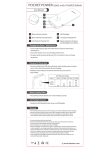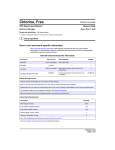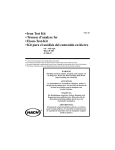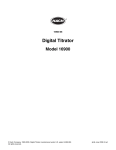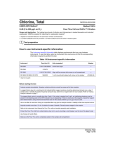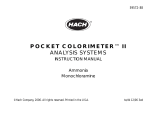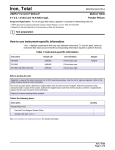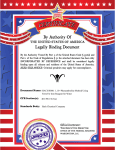Download SOP for calibrating and verifying lab equipment for discharging with
Transcript
PH METHOD # 4500-H+ B 1. Instrument calibration: In each case follow manufacturer’s instructions for pH meter and for storage and preparation of electrodes for use. Recommended solutions for short-term storage of electrodes vary with type of electrode and manufacturer. Keep electrodes wet by returning them to storage solution whenever pH meter is not in use. 2. Calibrate the electrode system against standard buffer solutions of known pH: The Treatment Plant generally uses 4.0, 7.0 & 10.0. The buffer solutions should bracket the results of the sample. In some cases a two point buffer calibration may be used. Record the slope. 3. Sample analysis: Establish equilibrium between electrodes and sample by stirring sample to insure homogeneity; stir gently to minimize carbon dioxide entrainment. For buffered samples or those of high ionic strength, condition electrodes after cleaning by dipping them into sample for 1 minute. Blot dry, immerse in a fresh portion of the same sample, and read pH. With dilute, poorly buffered solutions, equilibrate electrodes by immersing in three or four successive portions of sample. Take a fresh sample to measure pH. TOTAL SUSPENDED SOLIDS METHOD # 2540 D 1. Preparation of glass-fiber filter disk: If prepared glass fiber filter disks are used, eliminate this step. Insert disk with wrinkled side up in filtration apparatus. Apply vacuum and wash disk with three successive 20-ml portions of reagent-grade water. Continue suction to remove all traces of water, turn vacuum off. Remove filter from filtration apparatus and transfer to an inert aluminum weighing dish. Dry in an oven at 103 to 105 degrees Celsius for 1 hour. Cool in a desiccator to balance temperature and weigh. Repeat cycle of drying or igniting, cooling, desiccating, and weighing until a constant weight is obtained or until weight change is less than 4% of the previous weighing or 0.5mg, whichever is less. Store in desiccator until needed. 2. Selection of filter and sample sizes: Choose sample volume to yield between 2 and 200mg dried residue. If volume filtered fails to meet minimum yield, increase sample volume up to 1 liter. If complete filtration takes more than 10 minutes, decrease sample volume. 3. Sample analysis: Assemble filtering apparatus and filter and begin suction.Wet filter with a small volume of reagent-grade water to seat it. Filter a measured volume of well mixed sample through the glass fiber filter. Wash filter with three successive 10 ml volumes of reagent-grade water, allowing complete draining between washings, and continue suction for about 3 minutes after filtration is complete. Samples with high dissolved solids may require additional washings. Carefully remove filter from filtration apparatus and transfer to an aluminum weighing dish as a support. Dry for at least 1 hour between 103 and 105 degrees Celsius in an oven, cool in a desiccator to balance temperature, and weigh. Repeat the cycle of drying, cooling, desiccating, and weighing until a constant weight is obtained or until the weight change is less than 4% of the previous weight or 0.5 mg., whichever is less. 4. Calculations: mg total suspended solids/L = (A-B) x 1,000,000_ sample volume, ml Where: A = Weight of filter + dried residue, grams. and B = Weight of filter, grams. ANALYTICAL BALANCES Analytical balances should be checked for accuracy annually by the manufacturer or other service technician. EPA suggests that all plants have on hand American Society of Testing Materials (ASTM) Class 1 weights to check the calibration of their balances. As a minimum, have a 1.0 gram, 2.0 gram, and 50.0 mg weight to be able to make checks over the generally used range of the balance. This information should be recorded in a log book or on daily test worksheet prior to using the balance. CHLORINE RESIDUAL TOTAL METHOD # 4500-Cl G Pour 10ml of sample into a sample cell. Wipe surface of cell clean and zero in meter. Add Total Chlorine Powder pillow to sample cell. Invert sample for 20 seconds. Wait 3 minutes. Place sample cell into instrument, cover & Read. * * The meter should be verified daily or before use with standards that bracket the results of the sample. Record these results. Refer to manufacturer procedures. Chlorine Free, Indophenol, 10241 Free and total chlorine analyzer verification DOC316.53.01302 0.05 to 4.00 mg/L as Cl2 This document contains test procedures to support USEPA Method 334.0, Determination of Residual Chlorine in Drinking Water using an On-line Chlorine Analyzer. It is primarily intended to be used by drinking water facilities for compliance with daily monitoring requirements. The appropriate section of the USEPA method is referenced in each test procedure. USEPA Method 334.0 summary: An online chlorine analyzer is used to continuously monitor the chlorine concentration at a drinking water sample point. The instrument is calibrated using aqueous standards or the results from paired grab samples that are collected at the same sample point and time. The grab samples are analyzed for chlorine (free or total) using a method that is approved for drinking water compliance monitoring. The online analyzer accuracy is periodically verified/adjusted based on results from grab sample analyses. Prerequisites: • Read the procedures to make sure that all labware is properly treated, the correct reagent quality is available and the procedures and calculations are clearly understood. • Read the details and precautions in the procedures to make sure that the precision and accuracy requirements of Method 334.0 are achieved. • Make a decision about whether free chlorine or total chlorine will be measured. • Make sure that the specified reagents are available. • Read the specific instrument procedures for chlorine determination (Method 10245, DPD Free Chlorine, or Method 10250, DPD Total Chlorine) for additional test details. • Use dedicated labware and reagents to reduce preparation and analysis time and to prevent unintentional analysis errors. • Find out if additional test requirements have been added by the primacy agency. Test procedures: A. Verification of the chlorine calibration used for grab samples on page 1 B. Verification of secondary DPD Spec Check chlorine standards on page 5 C. Initial demonstration of capability (IDC) for field samplers on page 6 D. Initial calibration/verification of online chlorine analyzers on page 8 E. Initial demonstration of capability (IDC) for online chlorine analyzers on page 9 F. Routine verification of the calibration used for grab samples on page 11 G. Routine verification of the calibration for online chlorine analyzers on page 12 Start-up procedures A. Verification of the chlorine calibration used for grab samples EPA Method 334.0 reference: Start-up procedures section—grab sample method, paragraph 10.1.1 Scope and application: A requirement of USEPA Method 334.0, Section 10.1.1, is to verify the internal, factory-set calibration curve for grab-sample instruments that are used to measure the chlorine concentration of water samples. Three chlorine standard solutions that span the expected concentration range and one method blank must be used. The lowest concentration standard must be at or below 0.2 mg/L, or at or below the minimum chlorine residual requirement set by the primacy agency. Hach DPD Methods 10245 and 10250 for free or total chlorine, 0–4 mg/L Cl2, use internal factory-set calibration curves. These curves are verified using the following procedure. Free and total chlorine analyzer verification Page 1 of 14 TSS RELATIVE PERCENT DIFERENCE (RPD) CALCULATION 1. Analyze two aliquots of the same sample using the normal analytical method. 2. Calculate the value in mg/L for both aliquots. 3. Calculate the RPD: (A – B) x 100 = Relative Percent Difference Avg.A and B A = Higher of the two results B = Lower of the two results Example: Sample Result is 98 mg/L Duplicate Result is 103 mg/L Avg.A and B is (103 + 98) / 2 = 100.5 mg/L RPD is (103 – 98) x 100 = 4.97% 100.5 *Region 4 EPA requires an RPD of 15% or less. Checking Calibration of the Spectrophotometer / Colorimeter for Total Chlorine Residual STOCK STANDARD SOLUTION There are several vendors that now provide concentrated 0.891mg/L KmnO4 standard. Deionized water must never be stored in plastic containers or exposed to airborne contamination. The typical shelf life of the stock solution is six (6) months. Regardless what the expiration date states on the reagent bottle, if solids appear in the solution, do not use. ***Avoid leaving the cap off for extended periods of time and avoid contamination. *** INTERMEDIATE (WORKING) STANDARD SOLUTION (10 mg/L) 10 mL of STOCK made in 1000 mL vol. flask made to mark with deionized water is equivalent to 10 mg/L. The flask should be labeled with the name, KMnO4, date of preparation, initials of who made it. This information should also be entered into a logbook. Care should be taken that the pipette and glassware are clean and thoroughly rinsed with deionized water to avoid contamination. Store only in glass container (preferably amber glass) never in plastic containers. The working solution should be remade if solids appear in the bottom of the container. ***The solution should be remade no less than once per month.*** CALIBRATION STANDARD SOLUTIONS The table below provides guidance in preparing standards. A target value (e.g. permit value for a facility) should be known and should be bracketed by two working standards. (e.g. If the permit limit is 0019, then use 0.00 and 0.1mg/L.) These are used to check the instrument calibration, only. The instrument should read within 10% of the standard’s true value. These solutions should be made once per day (or once every 8 hours). Both the standard true value and the meter reading should be entered into the logbook ***Don’t forget to use the DPD reagent when checking the calibration of the instrument*** mL Working Standard Diluted w/Deionized water Chlorine Equivalent mg/L 20 mL (vol. Pipette) to 100 mL (vol. flask) 10 mL (vol. Pipette) to 100 mL (vol. flask) 5 mL (vol. Pipette) to 100 mL (vol. flask) 1 mL (vol. Pipette) to 100 mL (vol. flask) 3 mL (vol. Pipette) to 500 mL (vol. flask) 1 mL (vol. Pipette) to 200 mL (vol. flask) 2 mL (vol. Pipette) to 500 mL (vol. flask) 0.5 mL (vol. Pipette) to 200 mL (vol. flask) 1 mL (vol. Pipette) to 500 mL (vol. flask) 2.0 mg/L 1.0 mg/L 0.5 mg/L 0.1 mg/L 0.06 mg/L 0.05 mg/L 0.04 mg/L 0.025 mg/L 0.02 mg/L 100 mL of deionized water 0.00 mg/L ***Pipette the appropriate amount needed to fill the sample cell. Use a 10-mL volumetric pipette to deliver the standard solution to a 10-mL sample cell.*** Perform a chlorine analysis on the following (don’t forget the DPD reagent): a. b. c. d. Deionized water blank, 0.00 mg/L The 2 calibration standards that bracket or are the closest to the target value. Read the results on the meter and record results. Recheck, if the calibration standards do not read close to the chlorine equivalent. If the analyses do not read close (within 10%), remake the calibration standards first, then try a new battery. If the readings still do not read close, have the meter repaired. Update 02-10-2009 BGL Free and total chlorine analyzer verification Before starting the test: Calculate and record the concentration and dilution ratios for the required chlorine standard solutions. Refer to How to calculate the concentration of chlorine standard solutions on page 3. Use only chlorine demand-free glassware and organic-free or chlorine demand-free dilution water. Analyze chlorine standards immediately after preparation. Follow the analysis procedure for Method 10245 for free chlorine or Method 10250 for total chlorine. Test procedure Preparation and analysis of the chlorine verification standards 1. Add approximately 25 mL of organic-free water into a clean 50-mL or 100-mL volumetric flask. 2. Open a chlorine standard solution ampule, 50-75 mg/L Cl2. 3. Use a pipettor to add the calculated volume of the standard solution into the flask. Refer to How to calculate the concentration of chlorine standard solutions on page 3. 4. Dilute to the mark with organic-free water. Stopper and invert several times to mix. 5. Repeat as needed for preparation of additional standard concentrations. 6. Select the program number or channel for Method 10245 or Method 10250 DPD Free or Total Chlorine on the grab-sample instrument. 7. Fill a sample cell with organic-free water to set the instrument zero. Insert the sample cell into the instrument and push ZERO. The display shows 0.00 mg/l Cl2. 8. Add 1 DPD Free Chlorine or 1 DPD Total Chlorine Reagent Powder Pillow for a 25-mL sample to 10 mL of organic-free water (method blank). Cap and invert to dissolve the reagent. Note: DPD Total Chlorine Reagent may be used to verify the calibration curve for both free and total chlorine determinations. 9. Insert the prepared method blank into the instrument. Read and record the value at the time that is specified in the method test procedure. 10. Repeat step 8 for each of the prepared standards. 11. Insert the prepared standards into the instrument. Read and record the result at the time that is specified in the method test procedure. 12. Compare the measured values of the prepared standards to the calculated values. If the measured values are within ±15% of the calculated values for the prepared chlorine standard solutions, the calibration curve is successfully verified. The measured value for the method blank must be equal to or less than 1/3 the concentration of the lowest standard used. If the measured values for the chlorine standards or method blank do not meet the acceptance criteria, refer to Troubleshooting when grab sample verification criteria is not met on page 3. Example: Three standard solutions were prepared. The calculated and measured chlorine concentrations are shown in Table 1. The measured concentrations are within the ±15% allowable range. The internal factory calibration curve is successfully verified. Free and total chlorine analyzer verification Page 2 of 14 Free and total chlorine analyzer verification Table 1 Comparison of calculated and measured standard values (in mg/L Cl2) 1 Standard Calculated concentration Allowable range (±15%) Measured concentration Status Blank — 0.00–0.061 0.01 mg/L Pass Std 1 0.20 mg/L 0.17–0.23 0.21 mg/L Pass Std 2 1.60 mg/L 1.36–1.84 1.62 mg/L Pass Std 3 3.50 mg/L 2.98–4.03 3.49 mg/L Pass 1/3 or less of the Standard 1 value Troubleshooting when grab sample verification criteria is not met If the verification criteria for grab samples is not met: • Repeat the test procedure to confirm the results. • Make sure that the glassware and water that is used is free of chlorine demand. • Refer to the user manual for the grab sample instrument and complete the Calibration Adjust procedure. Use a chlorine standard concentration that is near the mid range of the test method. After the Calibration Adjust procedure is complete, repeat the test procedure for verification of the grab sample method. How to calculate the concentration of chlorine standard solutions Chlorine standard solutions are prepared by dilution of a concentrated (50 to 75 mg/L Cl2) chlorine standard contained in ampules. The actual concentration changes for each lot of standard and is printed on the package label. 1. Calculate the volume of standard solution to be pipetted from the ampule: Desired final chlorine concentration × Volumetric flask volume- = Estimated pipetted volume -----------------------------------------------------------------------------------------------------------------------------------------------------------------Ampule standard concentration (from label) 2. Round the estimated volume to the nearest 0.05 mL (most pipettors read to 0.05 mL only). 3. Calculate the actual concentration of the diluted standard solution: Actual pipet volume × Ampule standard concentration (from label) = Diluted standard concentration ----------------------------------------------------------------------------------------------------------------------------------------------------------------------------Volumetric flask volume Example: Desired chlorine concentration: 1 mg/L Cl2 Ampule standard concentration from label: 65.3 mg/L Cl2 Volumetric flask volume: 50 mL Estimated volume of ampule standard solution to be used: 1 mg/L × 50 mL- = 0.766 mL ---------------------------------------65.3 mg/L Concentration of diluted standard using actual pipette volume: 0.75 mL × 65.3 mg/L- = 0.98 mg/L ----------------------------------------------------50 mL Use a pipettor to add 0.75 mL of a 65.3 mg/L chlorine standard solution into a 50-mL volumetric flask. Dilute to the mark with chlorine demand-free water to make a 0.98 mg/L chlorine standard. Free and total chlorine analyzer verification Page 3 of 14 Free and total chlorine analyzer verification Additional examples of chlorine standard solutions are shown in Table 2. Table 2 Examples of volumes used to prepare chlorine standard solutions Desired concentration Ampule standard concentration Volumetric flask volume Calculated pipette volume Actual pipette volume Final concentration 0.10 mg/L 65.3 mg/L 100 mL 0.153 mL 0.20 mL 0.13 mg/L 0.20 mg/L 65.3 mg/L 100 mL 0.306 mL 0.30 mL 0.20 mg/L 1.00 mg/L 65.3 mg/L 50 mL 0.766 mL 0.75 mL 0.98 mg/L 2.00 mg/L 65.3 mg/L 50 mL 1.531 mL 1.55 mL 2.02 mg/L 4.00 mg/L 65.3 mg/L 50 mL 3.062 mL 3.05 mL 3.98 mg/L Treatment of glassware for chlorine demand Pretreat glass sample containers to remove any chlorine demand by soaking the container in a dilute bleach solution (1 mL commercial bleach in 1 L of deionized water) for at least 1 to 3 hours. Rinse thoroughly with deionized or distilled water. If sample containers are rinsed thoroughly with deionized or distilled water after use, only occasional pretreatment is necessary. Sample cells Do not use the same sample cells for free and total chlorine testing. A trace of iodide from the total chlorine reagent can contaminate the free chlorine test and cause a monochloramine interference. It is best to use separate, dedicated sample cells for free and total chlorine measurements. Chlorine demand-free water Hach Company organic-free water is acceptable for the preparation of chlorine standards and eliminates the need to prepare chlorine-demand free water. Procedures for the preparation of chlorine demand-free water are included in ASTM-D 1253-06 and Standard Method 4500-Cl C. Replacement parts and reagents Reagents Description Unit Catalog number 100/pkg 1407099 100/pkg 1406499 Ampule, 50–75 mg/L 20/pkg 1426820 Chlorine Standard Solution, 10-mL Voluette® Ampule, 50–75 mg/L 16/pkg 1426810 each 2980500 500 mL 2641549 DPD Free Chlorine Reagent Powder Pillows for 25-mL samples or DPD Total Chlorine Reagent Powder Pillows for 25-mL samples Chlorine Standard Solution, 2-mL PourRite® or DPD Chlorine-MR Spec Check Secondary Standards Kit Organic-free water Apparatus Description Unit Catalog number Ampule Breaker Kit, 10-mL Voluette Ampules each 2196800 Ampule Breaker, 2-mL PourRite Ampules each 2484600 Flask, volumetric, 50 mL each 1457441 Flask, volumetric, 100 mL each 1457442 Gloves, chemical resistant, size 101 each 2410105 Goggles, safety, standard each 2927902 Notebook, field each 2091800 Pipet, variable volume, 0.2–1.0 mL each BBP078 Free and total chlorine analyzer verification Page 4 of 14 Free and total chlorine analyzer verification Apparatus (continued) Description Pipet Tips, for BBP078 pipet Unit Catalog number 100/pkg BBP079 each BBP065 75/pkg BBP068 4L 27256 188/pkg 2932800 or Pipet, variable volume, 1.0–5.0 mL Pipet Tips, for BBP065 pipet Water, deionized Wipes, disposable, 28 x 37 cm 1 Additional sizes available B. Verification of secondary DPD Spec Check chlorine standards EPA Method 334.0 reference: Start-up procedures section—grab sample method, paragraph 10.1.1.3 Scope and application: USEPA Method 334.0 allows the use of secondary standards to support the grab sample method. The standards must be verified before use by measurement in an instrument with a calibration curve that was recently verified with grab samples. The Hach DPD Chlorine-MR Spec Check Secondary Standards are designed to support the grab sample testing requirements in Method 334.0. The secondary standards must be verified for each grab sample instrument that will be used. Specific chlorine values are assigned to each Chlorine Spec Check Secondary Standard at the time of verification on a verified chlorine grab-sample calibration curve. During routine use, the assigned values for the Spec Check standards must be within ±10% of their assigned value when compared to the value obtained on the grab sample instrument. Before starting the test: Use the DPD Chlorine-MR Spec Check Kit with Hach Method 10245 for DPD Free Chlorine and Method 10250 for DPD Total Chlorine. Review the Spec Check kit instructions printed on the kit label and on the certificate of analysis. Use the Spec Check blank vial included with the kit. Record the instrument identification and program number directly on the Record of Performance Verification included with the kit. One Record of Performance Verification is required for each grab sample instrument. It is best to obtain a set of Spec Check standards for each grab sample instrument, so that they will be available for calibration verification at all times. Secondary standards must be also be verified each time a grab-sample instrument calibration curve is changed. Secondary standards must not be used beyond the expiration date on the kit label. Test procedure 1. Select the grab-sample instrument program for 0–4 mg/L chlorine, DPD Method 10245 or Method 10250, on the instrument. 2. Wipe each Spec Check vial with a clean tissue. 3. Insert the Spec Check Blank into the instrument and push ZERO. 4. Insert STD 1 into the instrument and push READ to show the chlorine value. 5. Write the chlorine value on the Record of Performance Verification label. Free and total chlorine analyzer verification Page 5 of 14 Free and total chlorine analyzer verification 6. Repeat steps 4 and 5 with STD 2 and STD 3. 7. Attach the completed Record of Performance Verification label to the instrument. When the chlorine values are assigned from the verified grab sample instrument, the verification of the secondary standards is complete. Subsequent measurements on the same instrument should be within 10% of the assigned value. Replacement parts and reagents Reagents and apparatus Description DPD Chlorine-MR Spec Check Secondary Standards Kit Wipes, disposable, 28 x 37 cm Unit Catalog number each 2980500 188/pkg 2932800 C. Initial demonstration of capability (IDC) for field samplers EPA Method 334.0 reference: Start-up procedures section—grab sample method, paragraph 10.1.2 Scope and application: Each field sampler or person responsible for verification of online chlorine analyzers must first complete an initial demonstration of capability (IDC) before the grab sample method can be used to verify the accuracy of online chlorine analyzers. The IDC requires both an accuracy and precision calculation. Five replicates of a method blank and five replicates of a mid-range chlorine standard are run. The average concentration of the five replicates of the mid-range chlorine standard must be within ±15% of the expected chlorine concentration. The average value of the five method blank values must be equal to or less than 1/3 the value of the lowest chlorine concentration used to initially verify the grab sample instrument. The precision or scatter in the concentration values of the five chlorine standard replicates must have a relative standard deviation (RSD) equal to or less than 15% of the average value. Before starting the test: Read the procedure to understand the testing requirements and mathematical calculations required to complete the Initial Demonstration of Capability. A spreadsheet application can be used to calculate the statistics. Laboratory personnel can prepare the independent reference samples for analyses by the field samplers. Prepare glassware that is free of chlorine demand before preparation of the chlorine standard. Analyze the five replicate chlorine standards immediately. Use separate sample cells for free and total chlorine analysis to prevent contamination. Maintain a record of the IDC results for each field sampler. Test procedure—method blank accuracy 1. Collect the necessary chlorine demand-free glassware, pipets, organic-free water and the Chlorine Standard Ampule Solution. 2. Power on the instrument and select the program number or channel for the 0–4 mg/L DPD chlorine method. 3. Rinse a clean sample cell two times with organic-free water and then fill to the 10-mL mark. 4. Insert the sample cell into the instrument and push ZERO. The display shows 0.00 mg/L Cl2. 5. Remove the sample cell and add the contents of 1 DPD Free Chlorine or 1 DPD Total Chlorine Powder Pillow. Cap and shake gently to mix. Free and total chlorine analyzer verification Page 6 of 14 Free and total chlorine analyzer verification 6. Insert the prepared method blank into the instrument. Read the value at the time that is specified in the instrument test procedure. 7. Record the value and dispose of the solution. 8. Repeat steps 3–7 four additional times with the same sample cell to obtain the five replicate method blank values. 9. Calculate the accuracy and precision. Refer to Calculate the accuracy and precision. Test procedure—chlorine standard accuracy 1. Calculate the volume of 50–75 mg/L chlorine standard that is necessary to make an approximate 2 mg/L Cl2 standard solution. Approximately 100 mL of the diluted chlorine standard solution is required to complete the precision study. Refer to How to calculate the concentration of chlorine standard solutions on page 3. 2. Add approximately 25 mL of organic-free water to a clean 100-mL volumetric flask. 3. Open a Chlorine Standard Solution Ampule, 50–75 mg/L Cl2. 4. Pipette the volume of the chlorine standard solution that was calculated in step 1 into the flask. 5. Fill the flask to the mark with organic-free water, stopper and gently invert several times to mix. 6. Immediately rinse a clean sample cell two times with a small portion of the diluted chlorine standard. Fill the sample cell to the 10-mL mark with the diluted standard. 7. Insert the sample cell into the instrument and push ZERO. The display shows 0.00 mg/L Cl2. 8. Remove the sample cell and add the contents of 1 DPD Free Chlorine or 1 DPD Total Chlorine Powder Pillow for 25 mL samples. Cap and shake gently to mix. 9. Insert the prepared standard into the instrument. Read the result at the time that is specified in the instrument test procedure. 10. Record the value and dispose of the solution. 11. Repeat steps 6–10 four additional times with the same sample cell to obtain the 5 replicate mid-range chlorine standard values. 12. Calculate the accuracy and precision. Refer to Calculate the accuracy and precision. Calculate the accuracy and precision Accuracy: of 5 replicate valuesAverage (X) = Sum -----------------------------------------------------------------5 of 5 replicate method blank valuesAverage (Method Blank) = Sum -------------------------------------------------------------------------------------------------------5 Precision: 1. Use a spreadsheet application or a calculator function to determine the standard deviation (S) of the five replicate chlorine standard values. 2. Calculate the Relative Standard Deviation (RSD): S RSD = ---- × 100% X where: S = the standard deviation for the 5 replicate standards X = the average value of the 5 replicate chlorine standards Free and total chlorine analyzer verification Page 7 of 14 Free and total chlorine analyzer verification Replacement parts and reagents Reagents Description Unit Catalog number 100/pkg 1407099 100/pkg 1406499 Ampule, 50–75 mg/L 20/pkg 1426820 Chlorine Standard Solution, 10-mL Voluette® Ampule, 50–75 mg/L 16/pkg 1426810 each 2980500 500 mL 2641549 Description Unit Catalog number Ampule Breaker Kit, 10-mL Voluette Ampules each 2196800 Ampule Breaker, 2-mL PourRite Ampules each 2484600 Flask, volumetric, 50 mL each 1457441 Flask, volumetric, 100 mL each 1457442 Gloves, chemical resistant, size 101 each 2410105 Goggles, safety, standard each 2927902 Notebook, field each 2091800 Pipet, variable volume, 0.2–1.0 mL each BBP078 100/pkg BBP079 DPD Free Chlorine Reagent Powder Pillows for 25-mL samples or DPD Total Chlorine Reagent Powder Pillows for 25-mL samples Chlorine Standard Solution, 2-mL PourRite® or DPD Chlorine-MR Spec Check Secondary Standards Kit Organic-free water Apparatus Pipet Tips, for BBP078 pipet or Pipet, variable volume, 1.0–5.0 mL Pipet Tips, for BBP065 pipet Water, deionized Wipes, disposable, 28 x 37 cm 1 each BBP065 75/pkg BBP068 4L 27256 188/pkg 2932800 Additional sizes available D. Initial calibration/verification of online chlorine analyzers EPA Method 334.0 reference: Start-up procedures section—online analyzer, paragraph 10.2.1 Scope and application: For the initial calibration or verification of the calibration of a newly installed online chlorine analyzer. After the installed analyzer shows stable values, grab samples are taken and analyzed for chlorine with a DPD chlorine method that has been recently verified. The values obtained with the grab sample method are used to verify the analyzer calibration curve. Before starting the test: Identify a collection point for the grab sample that is as close as feasible to the location where the sample enters the online chlorine analyzer. Collect the necessary instrument, reagents, labware and procedures for the grab sample test method. Find the user instructions for the online analyzer that includes adjustment of the calibration curve. Free and total chlorine analyzer verification Page 8 of 14 Free and total chlorine analyzer verification Test procedure 1. Measure each of the DPD Chlorine-MR Spec Check Secondary Standards in the colorimeter or spectrophotometer that is used to measure grab samples (section B on page 5). Acceptable readings verify that the instrument performance is good and has not changed after transport to the analyzer site. 2. Rinse a glass beaker or flask several times with the chlorine sample and then collect the sample in the beaker or flask. 3. Use the 0–4 mg/L DPD method (10245 or 10250) to measure the chlorine concentration of the sample with the grab-sample instrument. Use the same analysis techniques and precautions that were used for the Initial Demonstration of Capability (IDC) grab sample procedure (refer to procedure C on page 6). 4. Record the chlorine concentration of the grab sample. Compare this value to the value from the online analyzer. 5. If the measured value of the grab sample is different from the measured value of the online analyzer by more than 15%, adjust the calibration curve of the analyzer to match the grab sample chlorine value. Note: During routine operation of the analyzer, the readings must be within ±0.1 mg/L or ±15% of the grab sample value. Use this criterion as a guide for deciding when the analyzer is properly adjusted. 6. If the calibration of the analyzer was adjusted, repeat steps 2–5 until the reading from the chlorine analyzer agrees with the grab sample measurements. Replacement parts and reagents Reagents Description DPD Free Chlorine Reagent Powder Pillows for 25-mL samples Unit Catalog number 100/pkg 1407099 100/pkg 1406499 or DPD Total Chlorine Reagent Powder Pillows for 25-mL samples DPD Chlorine-MR Spec Check Secondary Standards Kit each Water, deionized, 4 L 27256 2980500 Water, deionized Apparatus Description Unit Catalog number Beaker, 100 mL, glass each 50042H Gloves, chemical resistant, size 101 each 2410105 Goggles, safety, standard each 2927902 Notebook, field each 2091800 188/pkg 2932800 Wipes, disposable, 28 x 37 cm 1 Additional sizes available E. Initial demonstration of capability (IDC) for online chlorine analyzers EPA Method 334.0 reference: Start-up procedures section—online analyzer, paragraph 10.2.2 Scope and application: The initial demonstration of capability (IDC) can only be started after the calibration verification (section D on page 8) is complete. The IDC takes a minimum of 14 days. The full IDC must be completed before the analyzer is used for compliance monitoring measurements. The data collected during the IDC must be recorded and maintained. Free and total chlorine analyzer verification Page 9 of 14 Free and total chlorine analyzer verification Before starting the test: The IDC is not required for previously installed chlorine analyzers if historical data shows agreement with grab sample analyses. Agreement is defined as being within ±0.1 mg/L or ±15% (whichever is greater) of the grab sample data. Historical data must show agreement for 14 continuous days without analyzer maintenance or calibration. For installations with multiple analyzers, the first analyzer must successfully complete the 14-day IDC. Agreement criterion for multiple analyzers is defined as being within ±0.1 mg/L or ±15% (whichever is greater) of the grab sample data. The IDC for the installation of multiple analyzers can be reduced to seven consecutive days or seven business days when the same model of analyzer is installed at each location. The water characteristics and treatment process must be the same at each location. Make sure that the calibration for grab sample measurements is verified before the IDC process is started. Make sure that the IDC requirements for grab sample measurements with the field sampler is completed before the IDC process is started. Test procedure 1. Analyze two grab samples for chlorine using the program, instrument and procedure of a recently verified measurement system. The samples should be collected at concentrations that represent the daily chlorine high and low values as indicated by the analyzer. 2. The data for the two grab samples must be within the ±0.1 mg/L or ±15% acceptance criterion of the analyzer values. 3. Repeat steps 1–2 for 14 consecutive days or 14 consecutive business days. 4. When 14 consecutive days of data pairs meet the acceptance criterion, the analyzer can be put into service for compliance monitoring. Note: When operation is stopped for analyzer maintenance, the accuracy of the analyzer must be verified with a grab sample. The accuracy must be verified again after one day of operation. Replacement parts and reagents Reagents Description Unit Catalog number 100/pkg 1407099 100/pkg 1406499 DPD Chlorine-MR Spec Check Secondary Standards Kit each 2980500 Water, deionized, 4 L 27256 Water, deionized Unit Catalog number each 50042H DPD Free Chlorine Reagent Powder Pillows for 25-mL samples or DPD Total Chlorine Reagent Powder Pillows for 25-mL samples Apparatus Description Beaker, 100 mL, glass 101 each 2410105 Goggles, safety, standard each 2927902 Notebook, field each 2091800 188/pkg 2932800 Gloves, chemical resistant, size Wipes, disposable, 28 x 37 cm 1 Additional sizes available Free and total chlorine analyzer verification Page 10 of 14 Free and total chlorine analyzer verification Routine Monitoring Procedures F. Routine verification of the calibration used for grab samples EPA Method 334.0 reference: Routine procedures section—grab sample method, paragraph 11.1 Scope and application: This procedure verifies the grab sample method that is used to monitor the online chlorine analyzer during normal operation. The grab sample method must be verified at a minimum of once quarterly or whenever a grab sample is used to adjust the calibration of the online analyzer. Before starting the test: Collect the necessary chlorine demand-free glassware, pipets, organic-free water and the Chlorine Standard Ampule Solution. An aqueous chlorine check standard is prepared at a concentration near the expected chlorine concentration of the water samples. The results of the check standard must be within ±15% of the calculated value. If the results are different by more than 15%, the problem must be corrected before the grab sample method can be used to verify online measurements. DPD Free Chlorine Reagent Powder Pillows or DPD Total Chlorine Reagent Powder Pillows for a 25-mL sample size are used. The results of the check standard measurement must be recorded and maintained according to the requirements of the primacy agency. Secondary DPD Chlorine-MR Spec Check Standards can be used to make sure that the performance of the grab sample instrument has not changed. Test procedure 1. Calculate the volume of a 50–75 mg/L chlorine standard that is necessary to make a chlorine standard solution that is near the typical concentration of the water sample. Refer to How to calculate the concentration of chlorine standard solutions on page 3. 2. Power on the instrument that is used for grab sample measurements and select the program number or channel for the 0–4 mg/L chlorine method. 3. Add approximately 25 mL of organic-free water to a clean 50-mL or 100-mL volumetric flask. 4. Open a Chlorine Standard Solution Ampule, 50–75 mg/L Cl2. 5. Pipette the volume of the chlorine standard solution that was calculated in step 1 into the flask. 6. Fill the flask to the mark with organic-free water, stopper and gently invert several times to mix. 7. Immediately rinse a clean sample cell 2 times with a portion of the diluted chlorine standard. Fill the sample cell to the 10-mL line with the diluted standard. 8. Insert the sample cell into the instrument and push ZERO. The display shows 0.00 mg/L Cl2. 9. Remove the sample cell and add the contents of 1 DPD Free Chlorine or 1 DPD Total Chlorine Powder Pillow. Cap and shake gently to mix. 10. Insert the prepared standard into the instrument. Read the result at the time that is specified in the instrument test procedure. 11. Record the value and dispose of the solution. 12. Compare the measured value to the calculated value. If the measured value is within ±15% of the calculated value, the grab sample method can be used to verify online analyzer accuracy. Free and total chlorine analyzer verification Page 11 of 14 Free and total chlorine analyzer verification Replacement parts and reagents Reagents Description Unit Catalog number 100/pkg 1407099 100/pkg 1406499 Ampule, 50–75 mg/L 20/pkg 1426820 Chlorine Standard Solution, 10-mL Voluette® Ampule, 50–75 mg/L 16/pkg 1426810 each 2980500 500 mL 2641549 4L 27256 DPD Free Chlorine Reagent Powder Pillows for 25-mL samples or DPD Total Chlorine Reagent Powder Pillows for 25-mL samples Chlorine Standard Solution, 2-mL PourRite® or DPD Chlorine-MR Spec Check Secondary Standards Kit Organic-free water Water, deionized Apparatus Description Unit Catalog number Ampule Breaker Kit, 10-mL Voluette Ampules each 2196800 Ampule Breaker, 2-mL PourRite Ampules each 2484600 Flask, volumetric, 50 mL each 1457441 each 1457442 Flask, volumetric, 100 mL each 2410105 Goggles, safety, standard each 2927902 Notebook, field each 2091800 Pipet, variable volume, 0.2–1.0 mL each BBP078 Gloves, chemical resistant, size 1 101 Pipet Tips, for BBP078 pipet 100/pkg BBP079 Wipes, disposable, 28 x 37 cm 188/pkg 2932800 Additional sizes available G. Routine verification of the calibration for online chlorine analyzers EPA Method 334.0 reference: Routine procedures section—online analyzers, paragraph 11.2 Scope and application: This procedure uses the grab sample method to verify the accuracy of online chlorine analyzers during normal operation. The results of the grab sample measurements must be within ±0.1 mg/L or ±15% (whichever is greater) of the online analyzer value. Before starting the test: The maximum time between grab sample measurements must not exceed seven days. The grab sample should be taken as close to the analyzer as possible. Immediately analyze the collected grab sample. DPD Free Chlorine Reagent Powder Pillows or DPD Total Chlorine Reagent Powder Pillows for a 25-mL sample size are used. Use separate cells for DPD Free and DPD Total Chlorine testing to prevent cross-contamination. All data from the grab sample and analyzer comparison must be recorded and maintained according to the requirements of the primacy agency. Free and total chlorine analyzer verification Page 12 of 14 Free and total chlorine analyzer verification Test procedure 1. Power on the instrument and select the program number or channel for the 0–4 mg/L DPD chlorine method. 2. Rinse the glass sample container several times with the sample water and collect approximately 50 mL of sample. 3. Rinse a clean sample cell two times with the sample water and then fill to the 10-mL mark. 4. Insert the sample cell into the instrument and push ZERO. The display shows 0.00 mg/L Cl2. 5. Remove the sample cell and add the contents of 1 DPD Free Chlorine or 1 DPD Total Chlorine Powder Pillow. Cap and shake gently to mix. 6. Insert the prepared sample into the instrument. Read the result at the time that is specified in the instrument test procedure. 7. Record the chlorine value of the grab sample. Compare this value to the value from the online analyzer. The two values should be within ±0.1 mg/L or ±15% of each other. 8. If the measured value of the grab sample differs from the measured value of the online analyzer by more than ±0.1 mg/L or ±15%, the problem must be corrected. Refer to Troubleshooting disagreement between the grab sample and analyzer measurements. 9. Record the grab sample and analyzer comparison data. Maintain the data according to the requirements of the primacy agency. Troubleshooting disagreement between the grab sample and analyzer measurements If the measurements from Routine verification of the calibration for online chlorine analyzers on page 12 do not agree, complete the following tasks to correct the problem. 1. Collect a second grab sample and repeat the analysis to make sure the results are consistent. 2. Complete analyzer maintenance (flow adjustment, pH adjustment, cleaning, new membrane or fresh reagents, etc.) to make sure there are no problems with the analyzer. 3. For remote or field sites, use the DPD Chlorine-MR Spec Check Secondary Standards to make sure that the grab sample instrument response is accurate (section B on page 5). Note: If secondary standards were used to justify an analyzer calibration adjustment, complete the Routine verification of the calibration used for grab samples on page 11 within 24 hours with the same lot of reagents. 4. Verify the accuracy of the grab sample measurement with a chlorine check standard solution. Refer to Routine verification of the calibration used for grab samples on page 11. 5. If the accuracy of the grab sample was verified, adjust the calibration curve of the analyzer to match the grab sample chlorine value. Follow the user instructions for the online chlorine analyzer to adjust the analyzer calibration. 6. Collect another grab sample and measure the chlorine concentration to make sure that the analyzer and grab sample measurement agree. 7. Repeat steps 5 and 6 until the online analyzer measurements agree with the grab sample measurements. 8. After one day of operation, collect and measure an additional grab sample to make sure that the analyzer performance is accurate. 9. Return to the routine schedule for grab sample comparisons. A grab sample must be analyzed at least once each week. Free and total chlorine analyzer verification Page 13 of 14 Free and total chlorine analyzer verification Replacement parts and reagents Reagents Description Unit Catalog number 100/pkg 1407099 DPD Total Chlorine Reagent Powder Pillows for 25-mL samples 100/pkg 1406499 Chlorine Standard Solution, 2-mL PourRite® Ampule, 50–75 mg/L 20/pkg 1426820 16/pkg 1426810 each 2980500 500 mL 2641549 4L 27256 Unit Catalog number DPD Free Chlorine Reagent Powder Pillows for 25-mL samples or or Chlorine Standard Solution, 10-mL Voluette® Ampule, 50–75 mg/L DPD Chlorine-MR Spec Check Secondary Standards Kit Organic-free water Water, deionized Apparatus Description Ampule Breaker Kit, 10-mL Voluette Ampules each 2196800 Ampule Breaker, 2-mL PourRite Ampules each 2484600 Beaker, 100 mL, glass each 50042H Flask, volumetric, 50 mL each 1457441 Flask, volumetric, 100 mL each 1457442 each 2410105 Goggles, safety, standard each 2927902 Notebook, field each 2091800 Pipet, variable volume, 0.2–1.0 mL each BBP078 Gloves, chemical resistant, size 1 101 Pipet Tips, for BBP078 pipet 100/pkg BBP079 Wipes, disposable, 28 x 37 cm 188/pkg 2932800 Additional sizes available FOR TECHNICAL ASSISTANCE, PRICE INFORMATION AND ORDERING: In the U.S.A. – Call toll-free 800-227-4224 Outside the U.S.A. – Contact the HACH office or distributor serving you. On the Worldwide Web – www.hach.com; E-mail – [email protected] © Hach Company, 2010. All rights reserved. Printed in the U.S.A. HACH COMPANY WORLD HEADQUARTERS Telephone: (970) 669-3050 FAX: (970) 669-2932 February 2010, Edition 1


















